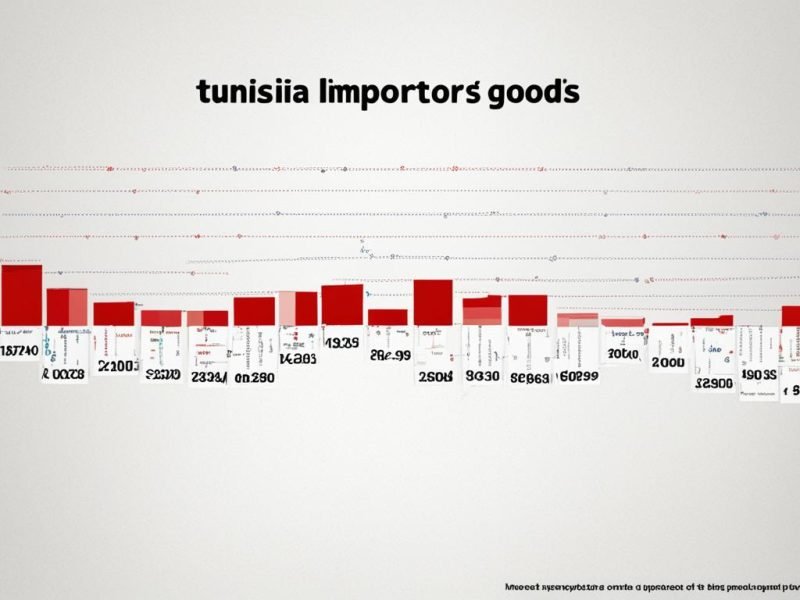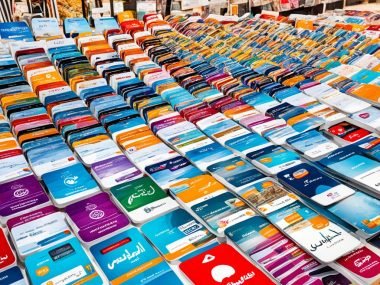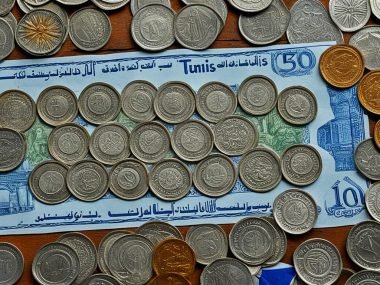Did you know Tunisia buys lots of goods from abroad? It imports 4,036 types of products. These come from 170 different countries all over the world. The total cost of these goods is about US$ 22,496 million. This shows that Tunisia plays a big part in world trade. By looking at where its imports come from, we can learn a lot about its economy and how it connects with other countries.
Key Takeaways
- Tunisia imports from 170 different source countries.
- Import origins span over 4,036 product lines.
- Total import value is approximately US$ 22,496 million.
- Diverse trade partners highlight Tunisia’s strategic economic links.
- Insight into Tunisia’s imports reveals its role in global trade dynamics.
Introduction to Tunisian Imports
Tunisia is now key in both Mediterranean and African trade. It imports a lot from many global suppliers.
The country’s trade actions show its important economic role. It brings in many goods, showing its economic scene and world connections. These goods include machinery and consumer items, showing Tunisia’s varied needs.
We need to look closely at Tunisia’s imports to understand its trade. This means studying its economic paths and the goods it buys. Lessons from this show Tunisia’s economic goals and its strong ties with other countries.
For example, Tunisia relies heavily on certain countries for imports. Detailed studies explain how Tunisia deals with world trade. Information on what it buys, how often, and from where shows Tunisia’s global market role.
Top Countries Tunisia Imports From
Tunisia buys a lot from a few key countries. Italy is a big help, giving 13.49% of what Tunisia needs. This makes Italy very important for Tunisia.
France, China, Germany, and Turkey also help a lot. They are crucial for Tunisia’s economy. Staying friends with these countries is key for Tunisia’s future.
| Country | Import Share (%) |
|---|---|
| Italy | 13.49% |
| France | 12.14% |
| China | 8.84% |
| Germany | 8.13% |
| Turkey | 4.41% |
Italy and France are very important for Tunisia. They send goods that help Tunisia’s shops and factories. This keeps Tunisia’s economy strong.
It’s important to understand these trade ties. They show how Tunisia gets what it needs. By keeping these countries close, Tunisia can keep growing.
Tunisia’s Import Statistics: An Overview
Tunisia’s import data shows it spent US $22,496 million on buying goods. This shows how important foreign trade is to Tunisia. It also points to strong ties with major trading countries.
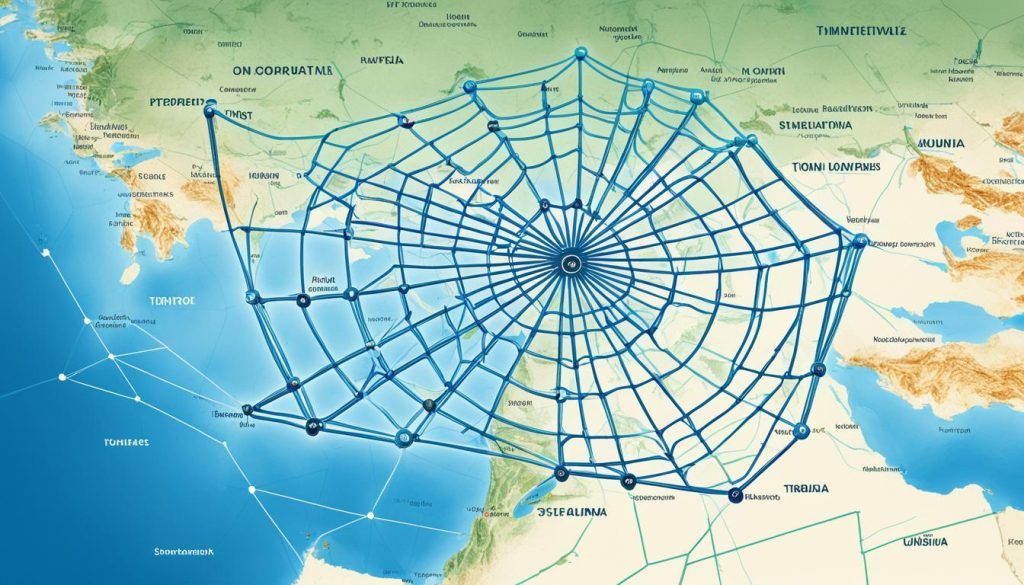
Annual Import Values
The yearly import numbers tell us a lot about Tunisia’s economy. They show Tunisia relies more on international trade every year. This highlights the importance of goods Tunisia buys from other countries.
Percentage Share by Country
Italy is Tunisia’s top source for imports at 13.49%. France is the next big supplier with 11.43%. Meanwhile, China is close behind, making up 10.39% of the total. These numbers show who Tunisia’s main trade partners are. They help us understand Tunisia’s trade network.
| Country | Percentage Share of Imports |
|---|---|
| Italy | 13.49% |
| France | 11.43% |
| China | 10.39% |
Where Does Tunisia Import From?
Tunisia buys things from many countries. We look at who sells the most to Tunisia here.
Italy as a Leading Supplier
Italy is a top seller to Tunisia. They are known for sending over great stuff. This includes machines and clothes worth US$ 3,034 million.
France’s Trade Relations with Tunisia
France has been friends with Tunisia in trade for a long time. They send things worth US$ 2,570 million. This has made their bond stronger over time.
The Role of China
China is important too. They sell Tunisia US$ 2,338 million of goods. Mostly electronics and machines Tunisians want.
| Country | Import Value (US$ Million) | Key Products |
|---|---|---|
| Italy | 3,034 | Machinery, Textiles |
| France | 2,570 | Automobiles, Pharmaceutical Products |
| China | 2,338 | Electronics, Machinery |
Major Products Imported by Tunisia
Tunisia imports many different things. We can learn about its trade by looking at the main items it brings in.
Petroleum Oils and Products
Petroleum oils and products are a big part of Tunisia’s imports. They cost about US$ 2,071,255.44. This shows how important they are for Tunisia’s energy and industries.
Electrical Apparatus for Switching
Electrical items for switching are also important. They are worth around US$ 447,198.60. These items help keep Tunisia’s power and technology running smoothly.
Wheat and Other Agricultural Imports
Wheat is another key import for Tunisia. It costs about US$ 402,354.08. This is vital for the country’s food and health.
Below is a summary table detailing the import values for Tunisia’s key product categories:
| Product Category | Import Value (US$) |
|---|---|
| Petroleum Oils and Products | 2,071,255.44 |
| Electrical Apparatus for Switching | 447,198.60 |
| Wheat and Other Agricultural Imports | 402,354.08 |
Tunisia’s imports show how it needs many different things. This includes energy and food from other countries.
Import Tariffs and Trade Barriers
Tunisia’s economy is hugely influenced by its import rules. Import duties help protect local industries. They also help balance trade and manage overseas competition. We look at tariffs on important items and other rules that affect imports in Tunisia.
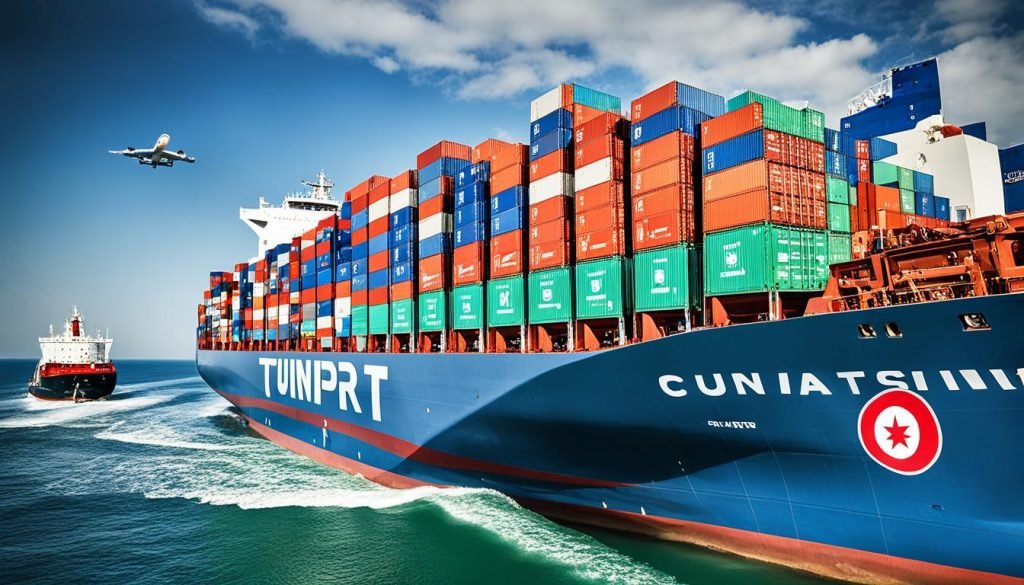
Tariff Rates on Key Products
Import duties in Tunisia change based on the item. On average, the tariff rate is about 10.21%. But, some goods, like farm products and clothes, can be taxed up to 36%. This helps protect local businesses and keeps the economy stable.
Non-Tariff Measures
Other rules, besides tariffs, matter too in Tunisia. There are licenses, quotas, and standards for foreign products. Even though we don’t have all the details, these rules are crucial. They make sure imported goods meet Tunisia’s safety and health standards.
Economic Impacts of Imports on Tunisia
Tunisia’s economy is tightly linked with its import activities. These have key trade impacts. Many different products now come into the country because of this.
Yet, this open door to the world’s goods also brings big challenges. Tunisia faces a trade deficit of -US$ 4,716.00 million. This shows a struggle in balancing payments without harming the economy. Local companies have to work harder to stay competitive.
Still, imports help by bringing in needed supplies. For things not made in Tunisia, this is crucial. It helps the economy grow steadily. Plus, getting advanced tools from overseas makes Tunisian businesses more productive.
| Metric | Value |
|---|---|
| Trade Balance Deficit | -US$ 4,716.00 million |
| Trade in Services (GDP Contribution) | -10.10% |
| Primary Import Benefits | Diversification, Technological Advancement |
| Primary Challenges | Competitive Pressure, Trade Balance |
Focus on the United Kingdom as a Trade Partner
The United Kingdom is Tunisia’s 98th biggest trade buddy. They have a small but important trading link. It’s useful to know about this trade to understand why it matters.
Trade Volume Statistics
The UK sent about £268 million worth of goods to Tunisia. Tunisia sent about £425 million worth of goods back. This shows the UK buys more from Tunisia than it sells. These numbers help us see how their trade is growing and changing.
Goods versus Services
The UK is doing more service business with Tunisia than before, seeing a 56.1% jump. On the other hand, Tunisia’s services to the UK went up by 9.7%. This shows they’re trading more services than goods. It tells us about their economic plans.
Historical Trends in Tunisian Imports
Looking into Tunisia’s trade history shows big changes in past trade patterns. This reveals how Tunisia’s economic goals and world standing have changed. Over time, different countries have become important for imports. The kinds of goods Tunisia needs have also changed.
Early on, Tunisia’s import evolution was shaped by its colonial links and where it is on the map. European countries, like France and Italy, were key suppliers. Yet, as Tunisia’s economy and foreign ties grew, its sources of imports expanded.
Today, Tunisia works with more countries and brings in a wider mix of goods. This change aims to rely less on a few countries and make its economy stronger. A table below shows these changes in Tunisia’s imports, listing main partners and goods:
| Decade | Top Import Partners | Main Commodities |
|---|---|---|
| 1960s | France, Italy | Textiles, Machinery |
| 1980s | Germany, France | Automobiles, Chemicals |
| 2000s | China, France | Electrical Goods, Petroleum Products |
| 2020s | China, Italy | Electronics, Agricultural Products |
This table shows us that European countries have always been important in Tunisia’s trade history. But now, China is also an important partner. These past trade patterns show how Tunisia’s economy and global politics have shifted.
Future Projections for Tunisian Trade
Tunisia’s trade future looks bright, thanks to world economic trends and its growth plans. The country is ready for big changes in how it trades. These changes show Tunisia is strong and ready to modernise.
Its economy is set to grow, and it’ll buy and sell more different things. This change is key for Tunisia’s trade future. Tunisia’s great location helps it trade easily with Europe, Africa, and the Middle East.
It’s important to understand regional and trade policy changes. Tunisia’s focus on updating its economy will shape its trade future. It will likely spend more on trade facilities, new ideas, and green practices.
| Factor | Impact on Trade |
|---|---|
| GDP Growth | Increases import capacity and diversifies trade sources. |
| Development Strategies | Encourages modernisation and resilience in trade practices. |
| Regional Dynamics | Influences trade policies and economic predictions. |
| Trade Policy Shifts | Affects trade forecast and future trade prospects. |
In short, Tunisia’s trade future depends on its smart plans and the world economy. Dealing well with these factors is key for its economic growth in the future.
Conclusion
We’ve looked closely at Tunisia’s economic state and its world ties. Tunisia keeps strong links with many countries. These are key for its growth and stability. Nations like Italy, France, and the UK are important. They supply Tunisia with vital goods like oil and farm products.
Tunisia fits well into the world economy, adapting to changes. It uses its global relationships to tackle trade problems. These connections meet local needs and strengthen Tunisia’s economy against world troubles.
Tunisia’s trade future looks good. It plans to use its current friends and find new ones in growing markets. This shows how planning and adapting are key for a strong economy.
In wrapping up, Tunisia’s imports show its strong trade plans and big goals. A smart way in world trade can lead to growth and lasting gains for the country.
FAQ
Where Does Tunisia Import From?
What are Tunisia’s annual import values?
What is the percentage share of Tunisia’s imports by country?
How significant is Italy as a supplier to Tunisia?
What is France’s role in Tunisia’s import market?
How does China influence Tunisia’s imports?
What are the major products imported by Tunisia?
What are the import tariffs and trade barriers in Tunisia?
What economic impacts do imports have on Tunisia?
How does the United Kingdom engage as a trade partner with Tunisia?
What are the historical trends in Tunisia’s imports?
What are the future projections for Tunisia’s trade?
Source Links
- https://wits.worldbank.org/countrysnapshot/en/TUN/textview
- https://wits.worldbank.org/CountryProfile/en/Country/TUN/Year/LTST/TradeFlow/Import/Partner/by-country/Product/16-24_FoodProd
- https://assets.publishing.service.gov.uk/media/6672dee864e554df3bd0db4d/tunisia-trade-and-investment-factsheet-2024-06-20.pdf

